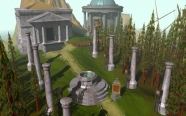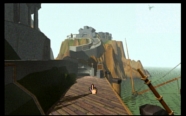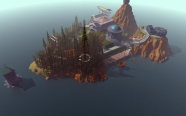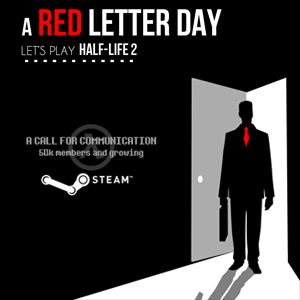Every week, Retro Game Wednesday reviews a well-aged game available for digital download on Steam.
—
Title: Myst: Masterpiece Edition
Genre: First Person Point and Click Adventure
Developer: Cyan
Release Date: 24 September, 1993
Price (at time of review): $5.99
Remember how amazing the graphics on some of these games were (or would have been) back in the 90’s? It’s funny how standards change so quickly. The technology does as well, of course, which makes possible the absurdly higher standards we have in the present. People could be impressed and games could be sold by such complex and groundbreaking features as enemies that could look in directions other than towards you. It seems terribly silly now but back then they were actually new and interesting features.
Of course, nowadays games that were sold on the appeal of the new technology of the 90’s alone don’t necessarily hold up. When a little adventure game called Myst came out in 1993, it was hailed as one of the best and most beautiful games on the market and helped push sales of then-new CD-ROM drives.
Will it hold up to modern criticism? Probably not, but let’s find out anyway.
SUMMARY
So you find a book and when you touch it you get pulled to a strange island known as Myst. Then you find some other books that have people trapped in them and they want you to let them out. But all is not as it seems. Also there are a lot of puzzles and very little in the way of help.
THE GOOD
- If you ARE a puzzle person, then you will quickly find that the puzzles range from obscure to obtuse in their solutions and require all manner of exploration and experimentation and lateral thinking. This game can really strain your brain if you’re the kind who refuses to look at a guide – you actually need to think a little.
- The story and background information is scattered throughout the world and the designers expect you to find it on your own – the game is full of books and cutscenes that you can skip through, but you need to have been paying attention to know what choice will lead you to the optimal ending.
- The game makes effective use of background sound effects and music to really pull you into the locations you’re exploring.
- Innovative and immersive first-person adventuring done well for the first time outside of a ‘dungeon crawler’.
- You can’t die at any point until the very end, so you’re free to explore the world and experiment without penalty as much as you care to.
THE BAD
- If you’re NOT a puzzle person, then you will quickly find that the puzzles range from obscure to obtuse in their solutions and require all manner of exploration and experimentation and lateral thinking. Except because you’re not a puzzle person you will not enjoy that at all and will quickly long for death.
- The game does have a hint button, but it serves only to mock you and prolong your suffering.
- You can’t die at any point until the very end, which if you don’t like puzzles means you are essentially trapped in your own very personal hell, progressing only in the pursuit of sweet, blessed release.
- Myst more than any of its sequels just doesn’t hold up graphically – while you can tell it would have all been quite impressive in 1993, nowadays it’s obviously a series of low resolution slides and low resolution QuickTime movies.
THE VERDICT
Again, the games that came after it were far more refined and hold up better today. But if you can ignore dated graphics and you like getting lost in immersive, full-formed worlds, this game could end up being worth your time. This game was revolutionary when it came out, but you might want to try out one of the later games first (all of them are available on Steam) to see if you even like the style of gameplay it pioneered. 5/10
THE IN-DEPTH
Computers started as oversized calculators that used to fill whole rooms. I don’t think anyone ever envisioned at their inception that they would end up being used as portals to whole other worlds. I’m not talking about the ones they had hooked up to the Stargate, either, as I have recently been informed that Stargate is not actually a documentary.
Before Myst, games didn’t really try very hard to immerse you. Whether you made a character or were assigned one by the designers of the game, nobody put very much effort into keeping up the illusion that it was you who was there in the game experiencing the events first-hand. In Doom, your character wasn’t you, it was the stoic and possibly constipated space marine whose face adorned your status bar. In other games, like Monkey Island, you were placed in a third-person perspective and could see at all times that the character you were playing was clearly not you at all, and even if you tried to pretend otherwise you would know deep down inside of you that no matter how hard you lied to yourself you would never have adventures like that, and no matter how much you hoped to be taken into a world full of pirates and other things that are cool, you were still all alone, sitting at a desk in front of one of those harsh glowing screens that serve to this day as your only real friends.
Myst tried to change all that. It was one of the first games that actually put effort into letting you play you. The very few characters in the game addressed you directly, avoiding names or any details about your appearance, so that you could insert yourself into the formless void that was the protagonist. And apart from that you were alone, left to wander empty worlds solving puzzles to bring you closer to your goal.
And it worked, or it did back then. Part of it was the fact that, unlike other adventure games of the time, there was no secondary narration or accompanying text descriptions for anything you happened to see. You had to look at the world, examine the mechanisms and contraptions that made up the puzzles, and draw your own conclusions. You couldn’t just click ‘look at device’ and have a convenient popup tell you what its purpose was – you had to look at it and try to figure that out for yourself.
That contributed a lot – you had to think for yourself, the game told you you were playing as yourself, and so, if you didn’t think about it too hard, you did. You let yourself get lost in the world they had created and solve the puzzles the way you would, not the way an assigned character in the game world would.
It was a hell of an experience for 1993. And no, it doesn’t hold up anywhere near perfectly today. But it was a big step in the right direction, and as games become more and more focused on the immersion aspect, trying to pull us wholly into the worlds they create, it can be quite educational to go back and see where it began.
Of course, you could also play the sequels, Riven or Myst 3: Exile. They’re both on Steam, and they’re prettier, and they do most of the same things. But if you’re a real retro games enthusiast, this game is still worth a playthrough. Or at least a play-until-you-get-frustrated-and-delete-it.
TECHNICAL NOTES
I also didn’t end up having any trouble running Myst on my machine, but if you have trouble you can feel free to contact me and I’ll tell you what you should type into Google.
Myst, myst 1![Retro Game Wednesday #12 – Myst: Masterpiece Edition Every week, Retro Game Wednesday reviews a well-aged game available for digital download on Steam. — Title: Myst: Masterpiece Edition Genre: First Person Point and Click Adventure Developer: Cyan Release Date: 24 September, 1993 […]](https://steamaddicts.com/wp-content/uploads/Myst-cover-616x308.jpg)




Leave a Reply